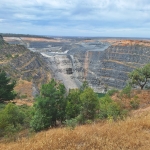US: A Quest for Oil Collides With Nature in Alaska
The 217,000 acres of windblown water and
mottled tundra here on the North Slope of Alaska, separating Teshekpuk
Lake from the Beaufort Sea, are home in summer to 50,000 to 90,000
migratory birds. This corner of Alaska's National Petroleum Reserve is
also thought to be brimming with oil.
From the presidencies of Ronald Reagan through Bill Clinton, federal officials put the bird habitat off limits to oil development. But after federal geologists in 2002 quadrupled their estimate of the oil available here in the northeast quadrant of the reserve, the Bush administration proposed putting the whole area up for lease to oil and gas companies.
The move has touched off a fierce debate over whether new technologies can allow wildlife to coexist easily with oil exploration. Here, among the crazy-quilt pattern of land and water, the question is particularly keen, because this is where Pacific black brant, snow geese and other migratory birds annually shed their feathers, and for six flightless weeks have minimal disturbance and a clear line of sight against predators.
How the dynamic of exploration, leasing and protest at Teshekpuk (pronounced teh-SHEK-puhk) and other parts of the oil patch plays out is seen by both sides in the debate as a harbinger of what awaits the Arctic shoreline - particularly as Congress prepares to vote this fall on drilling in the Arctic National Wildlife Refuge, east of Teshekpuk.
Henri Bisson, the Alaska director for the federal Bureau of Land Management, sees his office's proposals for leasing Teshekpuk for oil exploration as a blueprint for balancing environmental concerns and energy development on the North Slope.
Speaking of the Arctic refuge, Mr. Bisson said, "If ever there is development there, they'd have to look at what we're doing here, if not as a template, then as a potential development strategy."
But Stan Senner, executive director of Audubon Alaska, dismisses the talk of balance. "Oil companies and the people who are promoting oil development will go where the oil is," Mr. Senner said "and they won't stop at anything to get it."
Just how much oil is in the northeast corner of the reserve is a matter of professional guesses, most of them the proprietary information of companies. In 2002, the United States Geological Survey gave a mean estimate of 9.3 billion barrels, compared with the Arctic refuge's mean estimate of 7.7 billion barrels. The oil is concentrated, the geologists said, in the northern third of the petroleum reserve, which includes Teshekpuk.
Interest in the oil potential of that section of the reserve has grown as the older fields in Prudhoe Bay have passed their production peaks.
The Trans-Alaska Pipeline, the centerpiece of the advanced infrastructure that supports oil development in this forbidding climate, carries only about half its capacity of oil on the 800-mile journey to the Gulf of Alaska from the Beaufort Sea.
"What the industry is saying," said John B. Parry, a financial analyst, "is that we've invested billions of dollars in infrastructure, pipelines and so on, and we've got a 10- to 20-year bridge before we can switch our energy sources. So, do we want to take advantage of the already developed infrastructure of the oil fields to help ourselves?"
The question of whether, and how, to open seven lease tracts north and northeast of Teshekpuk is under consideration at the Interior Department. A spokeswoman for the White House Council on Environmental Quality said it might be months before a decision was made.
The two corporations that seem most interested in the rights are ConocoPhillips and British Petroleum, the successors of the companies that built the pipeline and the Prudhoe Bay industrial complex.
ConocoPhillips's 2005 annual report shows a three-year decline in its proven oil reserves in Alaska. The company is a 78 percent owner of the Alpine oil production facility, the closest large oil development to the disputed acres near Teshekpuk. With its partner, Anadarko, a smaller company based in Oklahoma, it has been pushing westward.
Company plans for access roads and power lines, on land leased from the Interior Department in the past six years, end about 15 miles from the easternmost area where the birds land in the summer.
Groups concerned with conservation, including allies of the Bush administration, are leery of any encroachment on the bird habitat. The hunting group Ducks Unlimited, whose Washington office has an endorsement from President Bush on its recorded telephone greeting, has lobbied hard to preserve the habitat.
The Pacific Flyway Council, which includes wildlife managers from 12 Western states, sent Interior Secretary Gale A. Norton a letter dated Aug. 1 saying that the molting area was "critical" to the Pacific black brant, whose numbers have declined.
A prominent group of Inupiat natives, including George N. Ahmoagak, the mayor of North Slope, a borough about the size of Minnesota, says that development not only disturbs geese but also threatens to infringe on native subsistence hunting rights. The Inupiats have supported the opening of the Arctic refuge.
A debate has arisen over an exploratory well, Puviaq No. 1, drilled by ConocoPhillips last winter at the western edge of the bird molting area. The well has provided data, kept private by the company, that indicate where oil and gas resources may be, and in what quantities.
Environmentalists say such wells intrude on a fragile web of wildlife. The oil industry says that the intrusion is minimal, pointing out the well's special trappings.
The wellhead is draped in black plastic, which deprives arctic ravens in search of juicy small birds of a 20-foot-high nesting site.
The well was rolled into place on vehicles with gargantuan soft tires that left little or no mark on the frozen ground. The industry says such measures, along with technology that allows oil companies to drill horizontally, will keep Teshekpuk's birds from being disturbed.
But critics say promises of environmental protections are not always kept. They cite an area in the Alpine oil development's western expansion that was once a federal buffer zone. The buffer was partly abandoned after the Bureau of Land Management approved an oil company plan to build a road through the area.
Mr. Bisson defended the bureau's action, saying that the accommodations for the road took wildlife more into account than "some arbitrary buffer."
Environmentalists also cite violations of emissions limits. Last fall, ConocoPhillips paid a state fine of $80,000 for exceeding permissible carbon monoxide levels at Alpine.
In a response to an e-mail query, a ConocoPhillips spokeswoman said that the company had "voluntarily reported air quality violations at its Alpine facility due to operational and mechanical incidents from start up in 1999-2003."
She added: "ConocoPhillips is committed to continued compliance with clean air regulations and monitors its Alpine operations closely."
The most recent federal proposal divides the land north of Teshekpuk Lake into seven large lease tracts, and stipulates that development - roads, drill pads, airstrips and the like - cannot exceed 300 acres on each tract. Under the plan, which awaits final approval, the only permanent structure that the birds would encounter would be a pipeline.
In a speech last year to a pro-development group in Anchorage, Kevin Meyers, the president of ConocoPhillips Alaska, speaking of North Slope development, said "overly restrictive lease stipulations will deprive Alaska of future production, jobs and revenue."
But Mr. Senner, of Audubon Alaska, said technological advances could not make the lease plan palatable. "We think it is still a very big deal, no matter how the technology has improved," he said. "An oil field is an oil field. It has production facilities. The pipeline has to be monitored constantly. There will be air traffic in and out. There will be roads."
- 107 Energy
- 190 Natural Resources



